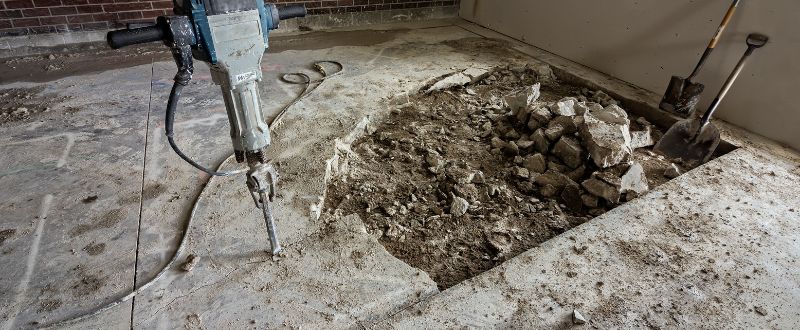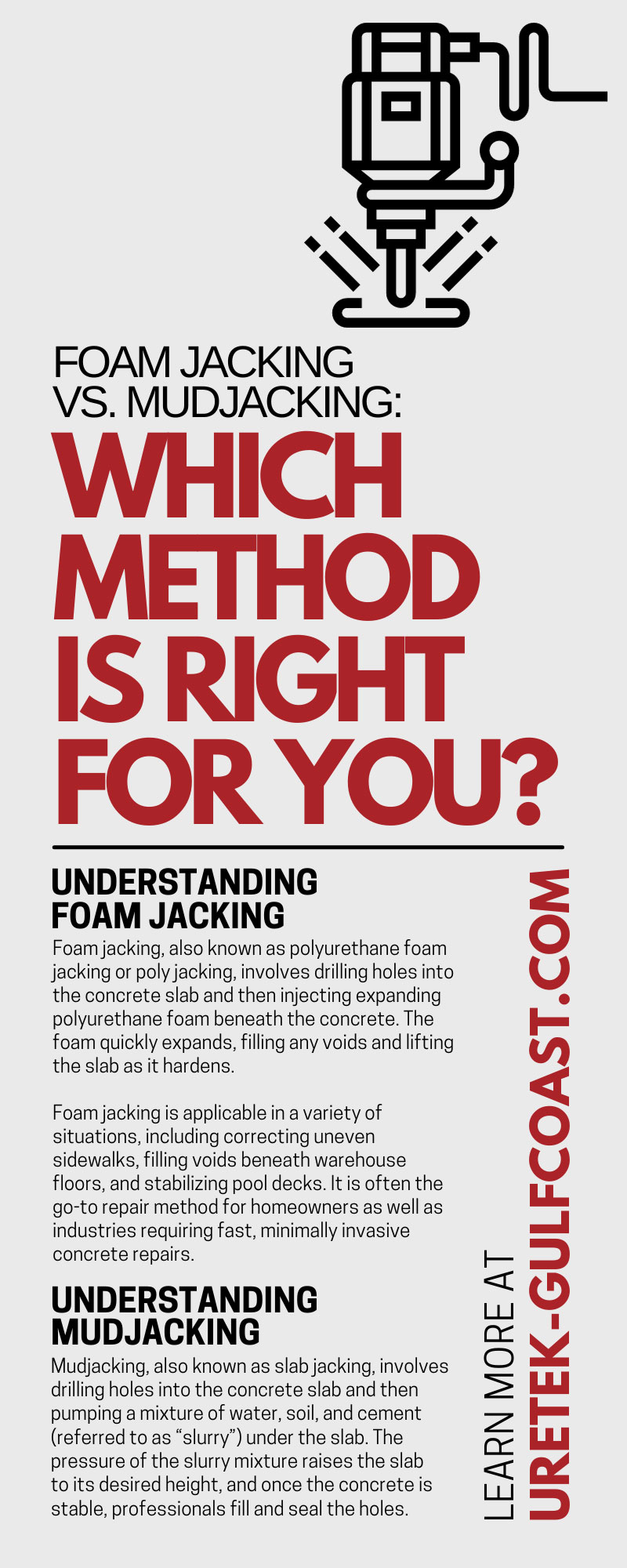Unstable concrete can create uneven surfaces, visible cracks, and potential tripping hazards. These symptoms diminish the visual appeal of your property and pose serious safety risks.
Unstable soil, moisture intrusion, and natural settling over time are common causes of concrete slab problems. It’s crucial to address these issues promptly to maintain structural integrity and prevent further damage. Compare two popular solutions, polyurethane injection and mudjacking, to find the right method for you.
Understanding Polyurethane Injection
Polyurethane injection, also known as polyurethane foam jacking or poly jacking, involves drilling holes into the concrete slab and then injecting expanding polyurethane foam beneath the concrete. The foam quickly expands, filling any voids and lifting the slab as it hardens.
Polyurethane injection is applicable in a variety of situations, including correcting uneven sidewalks, filling voids beneath warehouse floors, and stabilizing pool decks. It is often the go-to repair method for homeowners as well as industries requiring fast, minimally invasive concrete repairs.
A Closer Look at Expanding Polyurethane Foam
Expanding polyurethane foam is a unique material that exhibits versatile characteristics, making it an ideal candidate for concrete repair work. The two-part material begins as a liquid, but upon injection, the materials mix producing a chemical reaction.
The materials produce an exothermic reaction that cause them to foam and expand. As the mixed polyurethane expands it aggregates nearby loose soils and densifies.
Understanding Mudjacking
Mudjacking, also known as slab jacking, involves drilling holes into the concrete slab and then pumping a mixture of water, soil, and cement (referred to as “slurry”) under the slab. The pressure of the slurry mixture raises the slab to its desired height, and once the concrete is stable, professionals fill and seal the holes.
Mudjacking can be an effective solution for fixing sunken sidewalks, driveways, and garage floors. It’s a less expensive alternative to replacing the entire slab.
Comparing Mudjacking and Foam Jacking
Now that we’ve covered the basics of both techniques, let’s directly compare foam jacking and mudjacking to find the right method for your property.
Speed and Efficiency
Polyurethane foam foundation repair is faster than mudjacking, primarily because the polyurethane foam expands and cures more quickly than the slurry mixture. It has a shorter downtime, making it an ideal choice for commercial and industrial applications.
Mudjacking typically takes between 24 to 72 hours to cure; until cured, no one should walk on the treated concrete. In contrast, URETEK’s polyurethane foam hardens to 90 percent of its strength in 15 minutes. This speed means that with polyurethane foam, you’ll be able to use the treated area sooner.
Weight and Pressure
The polyurethane foam used in foam jacking is much lighter than the slurry mixture used in mudjacking. The lightweight foam puts less stress on the soil beneath the slab, reducing the likelihood of further sinking. Polyurethane foam can weigh about 3 pounds per cubic foot, while mud-jacking slurry can weigh more than100 pounds per cubic foot!
What makes polyurethane so much lighter? The foam comprises numerous tiny, tightly packed bubbles trapped during the reaction phase, creating a lightweight, expanded foam. In contrast, mudjacking slurry is heavier due to its composition of denser materials.
Disruption: Hole Size and Equipment
Mudjacking tends to be more invasive than foam jacking. The process requires larger holes, often 1 to 1.5 inches in diameter, drilled into the concrete slab to allow professionals to pump the slurry mixture underneath. The equipment used in mudjacking is also heavy and bulky, which can complicate the repair process, especially in tight spaces.
On the other hand, polyurethane jacking requires smaller holes, typically 5/8 inch in diameter, which is about the size of a penny. Smaller injection holes result in less visible disruption to the concrete slab.
The equipment used for polyurethane is also lighter and more compact, making access easier and causing less disruption to the surrounding area. This aspect becomes particularly beneficial when working in confined spaces.
Repair Cost
Mudjacking is often less expensive upfront, but foam jacking is usually more cost-effective than mudjacking over time. The mudjacking process may not always provide a permanent solution, and the repaired slab might still settle over time, leading to additional repair costs. The longer curing time and more significant disruption may also add indirect costs, particularly if the concrete slab is part of a commercial or industrial property.
The cost of foam jacking can vary depending on the complexity of the job, the size of the area in need of repair, and the amount of material required. Although comparing the upfront cost may make mudjacking seem more affordable, polyurethane injection repair lasts longer and saves significant time.
Treatment Durability
Polyurethane jacking employs the use of polyurethane foam, a resilient material known for its durability, strength, and waterproof properties. Once cured, the foam maintains its structure and doesn’t degrade or shrink over time, making it an excellent long-term solution for lifting and stabilizing concrete.
The density and weight of the slurry mixture can add stress to the underlying soil, which may contribute to future settling. While mudjacking can offer a reliable short-term solution for uneven concrete, it may not provide the same long-term stability and durability as foam jacking.
Water Intrusion Over Time
Polyurethane foam is also resistant to moisture, reducing the risk of future soil erosion beneath the slab, a common cause of concrete settling. This moisture resistance, coupled with the foam’s lightweight nature and expansive properties, helps to preserve the integrity of the underlying soil, thereby extending the lifespan of the concrete repair.
While the mudjacking slurry is certainly strong enough to lift and support the slab, it is susceptible to water infiltration over time. This issue can lead to soil erosion beneath the slab, causing the concrete to settle again and potentially necessitating repeat repairs.
Contact a Concrete Repair Specialist
Commercial and residential property owners often choose foam jacking over mudjacking for faster cure times, minimally invasive procedures, and long-lasting solutions. Ultimately, consulting with a professional can help you make the best decision for your specific situation.
URETEK ICR Gulf Coast has over 20 years of experience in industrial and commercial concrete repair services. Our team has state-of-the-art equipment and expertise to provide efficient, cost-effective solutions for all your concrete needs. Contact us today to learn more about our polyurethane foam injection services or schedule a consultation.


